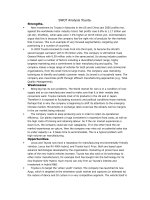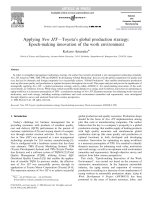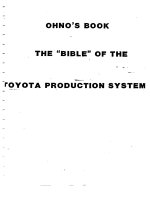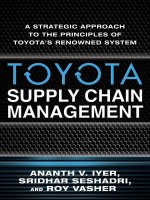Toyota kata
Bạn đang xem bản rút gọn của tài liệu. Xem và tải ngay bản đầy đủ của tài liệu tại đây (4.79 MB, 332 trang )
Tai Lieu Chat Luong
TOYOTA
K ATA
This page intentionally left blank
TOYOTA
K ATA
MANAGING PEOPLE FOR
IMPROVEMENT, ADAPTIVENESS,
AND SUPERIOR RESULTS
MIKE ROTHER
New York Chicago San Francisco Lisbon London
Madrid Mexico City Milan New Delhi San Juan
Seoul Singapore Sydney Toronto
Copyright © 2010 by Rother & Company, LLC. All rights reserved. Except as permitted under the United States
Copyright Act of 1976, no part of this publication may be reproduced or distributed in any form or by any means, or
stored in a database or retrieval system, without the prior written permission of the publisher.
ISBN: 978-0-0-7163985-9
MHID: 0-07-163985-3
The material in this eBook also appears in the print version of this title: ISBN: 978-0-07163523-3, MHID: 0-07-163523-8.
All trademarks are trademarks of their respective owners. Rather than put a trademark symbol after every occurrenc
of a trademarked name, we use names in an editorial fashion only, and to the benefit of the trademark owner, with nointention of infringement of the trademark. Where such designations appear in this book, they have been printed with initial caps.
McGraw-Hill eBooks are available at special quantity discounts to use as premiums and sales promotions, or for use in
corporate training programs. To contact a representative please e-mail us at
TERMS OF USE
This is a copyrighted work and The McGraw-Hill Companies, Inc. (“McGraw-Hill”) and its licensors reserve all rights
in and to the work. Use of this work is subject to these terms. Except as permitted under the Copyright Act of 1976 and
the right to store and retrieve one copy of the work, you may not decompile, disassemble, reverse engineer, reproduce,
modify, create derivative works based upon, transmit, distribute, disseminate, sell, publish or sublicense the work or any
part of it without McGraw-Hill’s prior consent. You may use the work for your own noncommercial and personal use;
any other use of the work is strictly prohibited. Your right to use the work may be terminated if you fail to comply with
these terms.
THE WORK IS PROVIDED “AS IS.” McGRAW-HILL AND ITS LICENSORS MAKE NO GUARANTEES OR WARRANTIES AS TO THE ACCURACY, ADEQUACY OR COMPLETENESS OF OR RESULTS TO BE OBTAINEDFROM USING THE WORK, INCLUDING ANY INFORMATION THAT CAN BE ACCESSED THROUGH THE
WORK VIA HYPERLINK OR OTHERWISE, AND EXPRESSLY DISCLAIM ANY WARRANTY, EXPRESS OR
IMPLIED, INCLUDING BUT NOT LIMITED TO IMPLIED WARRANTIES OF MERCHANTABILITY OR FITNESS FOR A PARTICULAR PURPOSE. McGraw-Hill and its licensors do not warrant or guarantee that the functions
contained in the work will meet your requirements or that its operation will be uninterrupted or error free. Neither
McGraw-Hill nor its licensors shall be liable to you or anyone else for any inaccuracy, error or omission, regardless of
cause, in the work or for any damages resulting therefrom. McGraw-Hill has no responsibility for the content of any
information accessed through the work. Under no circumstances shall McGraw-Hill and/or its licensors be liable for any
indirect, incidental, special, punitive, consequential or similar damages that result from the use of or inability to use the
work, even if any of them has been advised of the possibility of such damages. This limitation of liability shall apply to
any claim or cause whatsoever whether such claim or cause arises in contract, tort or otherwise.
Contents
Foreword
Acknowledgments
Introduction: Transforming Our Understanding of
Leadership and Management
Part I. The Situation
Chapter 1. What Defines a Company That Thrives
Long Term?
vii
xi
xiii
1
3
Part II. Know Yourself
21
Introduction to Part II
23
Chapter 2. How Are We Approaching Process Improvement? 25
Chapter 3. Philosophy and Direction
37
Chapter 4. Origin and Effects of Our Current
Management Approach
55
Part III. The Improvement Kata: How Toyota
Continuously Improves
73
Introduction to Part III
75
Chapter 5. Planning: Establishing a Target Condition
77
v
Contents
vi
Chapter 6. Problem Solving and Adapting: Moving
Toward a Target Condition
129
Summary of Part III
159
Part IV. The Coaching Kata: How Toyota Teaches
the Improvement Kata
171
Introduction to Part IV
173
Chapter 7. Who Carries Out Process Improvement
at Toyota?
175
Chapter 8. The Coaching Kata: Leaders as Teachers
185
Summary of Part IV
225
Part V. Replication:What About Other Companies?
229
Chapter 9. Developing Improvement Kata Behavior in
Your Organization
231
Conclusion
261
Appendix 1. Where Do You Start with the
Improvement Kata?
265
Appendix 2. Process Analysis
269
Bibliography
291
Index
297
Foreword
M
ike Rother’s Toyota Kata is a rare and exciting event — a
book that casts entirely new light on a much heralded set
of management practices, giving those practices new significance and power. Countless people in the past 20 or more years
have studied and written about Toyota’s wildly successful management thinking and practice. But paradoxically, despite the vast
amount of knowledge presented in these works, no organization outside Toyota’s family of companies has ever come close to matching
Toyota’s stellar performance. There is a widespread feeling that something Toyota does is still not understood and put into practice by
non-Toyota companies.
Toyota Kata will change all that. In this book, Mike Rother penetrates Toyota’s management methods to a depth never before reached.
In doing so, he offers a set of new ideas and practices that enables any
organization, in any business, to do what it takes to match Toyota’s
performance.
This is not the first book in which Mike Rother presents pathbreaking insights into Toyota. He advanced the business world’s understanding of Toyota’s methods light-years in his 1998 book Learning to
See, coauthored with John Shook. A brief look at the message of
vii
viii
Foreword
Learning to See explains how Toyota Kata advances that understanding
yet another order of magnitude.1
Learning to See describes and explains a mapping tool Toyota uses
to “see” how work moves from the start of production to delivering
finished product to the ultimate customer. Known inside Toyota as
“material and information flow mapping,” Rother, Shook, and publisher Jim Womack renamed Toyota’s tool “value-stream mapping”
and explained it for the first time in their book. Thanks to the enormous success of Learning to See, value-stream mapping became one
of the most widely used tools to teach and practice Toyota’s vaunted
production system.
With the value-stream mapping tool, Rother and Shook show
how to use many of Toyota’s well-known techniques systematically to
change a conventional batch-oriented mass-production factory flow
— replete with countless interruptions and massive delays—into a
flow resembling what one finds in a typical Toyota factory. Familiar
names for some of these techniques are takt time, andon, kanban,
heijunka, and jidoka. For most students of Toyota, Learning to See
was the first extensive and clear explanation into how to use Toyota’s
techniques to improve across an entire facility.
That book, however, does not explore why and how these techniques evolved, and continue to evolve, at Toyota. Although Learning
to See provides a monumental step forward in understanding how
Toyota achieved the remarkable results it has enjoyed for over 50 years,
it does not reveal why others, after implementing Toyota-style techniques, still seem unable to emulate Toyota’s performance. How does
Toyota develop its solutions? What specific process do they use? Now,
in Toyota Kata: Managing People for Improvement, Adaptiveness, and
Superior Results, Mike Rother shows us this next vital layer of Toyota
practice.
The central message of Toyota Kata is to describe and explain
Toyota’s process for managing people. Rother sets forth with great clarity and detail Toyota’s unique improvement and leadership routines, or
kata, by which Toyota achieves sustained competitive advantage. The
transformative insight in Toyota Kata is that Toyota’s “improvement
Foreword
ix
kata” and “coaching kata” both transcend the results-oriented level of
thinking inherent in the management methods still used in most companies in the Western world.
The findings in Toyota Kata confirm my own interpretation of what
I observed so often in Toyota operations since my first study mission to
Toyota’s giant facility (TMMK) in Georgetown, Kentucky, in 1992.2
What distinguishes Toyota’s practices from those observed in American
and other Western companies is their focus on what I call “managing
by means,” or MBM, rather than “managing by results,” or MBR. As
far back as 1992, I learned from President Fujio Cho and members of
his management team at Georgetown that Toyota steadfastly believes
that organizational routines for improvement and adaptation, not
quantitative/financial targets, define the pathway to competitive advantage and long-term organizational survival.
In this era, business organizations also have a great influence on
the nature of society. How these organizations operate and, especially,
the ways of thinking and acting they teach their members define not
only the organizations’ success but great swaths of our social fabric as
well. While a rapid advance of knowledge about human behavior is
now under way, those scientific findings are still too far removed from
the day-to-day operation of our companies. Business organizations
cannot yet access and use them to their benefit in practical ways.
Because Toyota Kata is about developing new patterns of thinking and
behavior in organizations, it provides a means for science to find application in our everyday lives. The potential is to reach new levels of performance in human endeavor by adopting more effective ways of
working, and of working together.
In my opinion, the greatest change Mike Rother’s Toyota Kata can
bring to the non-Toyota business world is to replace traditional financial-results-driven management thinking with an understanding that
outstanding financial results and long-term organization survival follow
best from continuous and robust process improvement and adaptation
—not from driving people to achieve financial targets without regard
for how their actions affect processes. What has prevented this change
from happening before now is the lack of a clear and comprehensive
x
Foreword
explanation of how continuous improvement and adaptation occur in
Toyota, the only company I know in the world that truly manages by
means, not by results. That explanation is now available to anyone who
studies Mike Rother’s findings and message in Toyota Kata.
H. Thomas Johnson
Portland, Oregon
Spring 2009
Notes
1 Mike Rother and John Shook, Learning to See: Value Stream Mapping
to Add Value and Eliminate Muda (Cambridge, Massachusetts: Lean
Enterprise Institute, 1998).
2 I recount my findings from these study missions in Chapter 3 and
other parts of H. Thomas Johnson and Anders Broms, Profit
Beyond Measure: Extraordinary Results Through Attention to Process
and People (New York: The Free Press, 2000; and London: Nicholas
Brealey Publishing, 2000 and 2008).
Acknowledgments
T
hank you to the many dozens of people who have given me
access to their companies and factories, who worked with me
or in parallel in testing ideas, engaged in discussion about
what we were learning, critiqued my thoughts, and were happy to
keep going.
This book also reflects an ongoing dialogue with an ardent group
of fellow experimenters, whom I count as colleagues, mentors, and
friends. Thank you to: John Shook (who was coincidentally preparing
a book on a related topic), Professor H. Thomas Johnson (Portland
State University), Dr. Ralph Richter (Robert Bosch GmbH), Gerd
Aulinger (Festool), Jim Huntzinger, Professor Jochen Deuse (Technical
University Dortmund), Dr. Andreas Ritzenhoff and Dr. Lutz Engel
(Seidel GmbH & Co. KG), Tom Burke and Jeff Uitenbroek (Modine
Manufacturing Company), and Keith Allman (Delta Faucet
Company).
Thank you also to a few exceptional people who over the years
have given me support, input, or guidance that opened doors,
moved my horizons, and created new possibilities: my wife, Liz
Rother, Dr. Jim Womack (Lean Enterprise Institute), Professor
xi
xii
Acknowledgments
Daniel T. Jones (Lean Enterprise Academy), Mr. Kiyoshi Suzaki,
Professor Jeffrey Liker (University of Michigan), and my daughters,
Grace and Olivia.
And, last but not least, a deep bow to Toyota for giving us such an
interesting subject about which to learn.
Introduction:Transforming
Our Understanding of
Leadership and Management
I
magine you have a way of managing that generates initiative among
everyone in the organization to adapt, improve, and keep the organization moving forward. Imagine that although this method is different from how we currently manage, it is ultimately not difficult to
understand. That is the subject of this book, which describes a way of
bringing an organization to the top, and keeping it there, by influencing
how everyone in it, yourself included, thinks, acts, and reacts.
In many organizations there is an unspoken frustration because of
a gap between desired results and what really happens. Targets are set,
but they are not reached. Change does not take place.
The music industry’s major labels, for example, were broadsided
by digital music downloads, even though the widespread popularity of
compiling homemade mix cassettes, starting over 30 years ago, indicated that the market was there. For several decades Detroit’s automakers chose not to focus on developing smaller, more efficient vehicles for
their product portfolios, despite repeated signals since the 1970s that
there was a growing market for them. More recently, PC industry
giants were late to develop compact, Internet-oriented laptops tailored
for Web surfing, e-mail, sharing photos, downloading music, and
watching videos, even though many people, sitting in plain view in
coffeeshops, use their laptop primarily for these tasks.
xiii
xiv
Introduction
Our reaction to the fate of the music industry, the automakers, the
PC companies, and hundreds of organizations like them is predictable:
we blame an organization’s failure to adapt on poor decision making
by managers and leaders, and we may even call for those leaders to be
replaced. Yet can there really be so many managers and leaders who
themselves are the problem? Is that the root cause? I can assure you
that we are on the wrong path with from-the-hip assertions about bad
managers, and that hiring new ones, or more MBAs, is not going to
solve this problem.
So what is it that makes organizations fall behind and even totally
miss the boat, and what can we do about it? What should we change, and
to what should we change it? Once you know the answers to these questions, you will be even more capable of leading and managing people, and
of ensuring that your organization will find its way into the future.
Most companies are led, managed, and populated by thoughtful,
hardworking people who want their organization, their team, to succeed. The conclusion has become clear: it is not the people, but rather
the prevailing management system within which we work that is a culprit. A problem lies in how we are managing our organizations, and
there is a growing consensus that a new approach is needed. But we
have not yet seen what that change should be.
Business authors sometimes suggest that well-established, successful companies decline, while newer companies do well, because the
new companies are not encumbered by an earlier, outmoded way of
thinking. On the surface that may seem true, but the important lesson
actually lies one step deeper. The problem is not that a company’s
thinking is old, but that its thinking does not incorporate constant
improvement and adaptation.
Drawing on my research about Toyota, I offer you a means for
managing people, for how leaders can conduct themselves, that is
demonstrably superior to how we currently go about it. I am writing for
anyone who is searching for a way to lead, manage, and develop people
that produces improvement, adaptiveness, and superior results. You
may be an experienced manager, executive, engineer, or perhaps you are
just starting to learn about or practice management. Your organization
Introduction
xv
may have only a few people or it may have thousands. You are successful, but you want to be better and still relevant tomorrow.
With that in mind, here is my definition of management:
The systematic pursuit of desired conditions by utilizing human
capabilities in a concerted way.
Since we cannot know the future, it is impossible to say what sort
of management systems we will be using then. However, precisely
because we cannot see ahead we can argue the following: that an effective management system will be one that keeps an organization adjusting to unpredictable, dynamic conditions and satisfying customers.
Situations may always be different from place to place and time to
time, so we cannot specify in advance what should be the content of
people’s actions. Leading people to implementing specific solutions
such as assembly cells, Six Sigma tools, kanban, diesel or hybrid power
trains, today’s high-margin product, and so on will not make an organization adaptive and continuously improving. Of greater interest is
how people can sense and understand a situation, and react to it in a
way that moves the organization forward.
One of the best examples we currently have of an adaptive, continuously improving company is Toyota. Of course, Toyota makes mistakes
too, but so far no other company seems to improve and adapt—every
day in all processes—as systematically, effectively, and continuously. Few
companies achieve so many ambitious objectives, usually on time and
within budget.
How Does Toyota Do It?
We have known for a long while that Toyota does something that
makes it more capable of continuously improving than other companies, and by now we have recognized that it lies in its management
approach. But how Toyota manages from day to day and thereby
embeds continuous improvement and adaptation into and across the
organization has not yet been explained.
xvi
Introduction
That is about to change.
In the ongoing effort to understand and describe what Toyota is
doing, most books provide lists of the organization’s practices or principles. The individual points may all be correct, yet making lists
circumvents explaining how Toyota manages people, and as our now
20 years of unsuccessfully trying emulate Toyota’s success shows, such
lists are not actionable. This is because an organization’s collection of
practices and principles at any point in time is an outcome that springs
from its members’ routines of thinking and behavior. Any organization’s competitiveness, ability to adapt, and culture arise from the
routines and habits by which the people in the organization conduct
themselves every day. It is an issue of human behavior.
The evidence of the last 20 years indicates that trying to copy
or reproduce another company’s tools, techniques, or principles does
little to change an organization’s culture, its way of doing things. For
example, how do you get people to actually live principles? On the
other hand, focusing on developing daily behavior patterns is a leverage point because, as the field of psychology shows us, with practice,
behavior patterns are changeable, learnable, and reproducible.
What has been missing, and the gap that Toyota Kata fills, is a
look inside the engine room, that is, a clear explanation of daily
behavior patterns at Toyota and how they are taught. By describing
these underlying thinking and behavior routines, Toyota Kata establishes the context within which the Toyota practices previously
observed and written about are developed and function. This gives
us new power.
This book describes two particular behavior routines, habits or
patterns of thinking and conducting oneself, that are practiced over
and over every day at Toyota. In Japan such routines are called kata.
These behavior patterns are not visible, are not described in Toyota
documents, and it takes a long time to recognize them. Yet they are
how Toyota leads and manages its people. These two kata are taught to
all Toyota employees and are a big part of what propels that company
as an adaptive and continuously improving organization. If you want
to understand Toyota and emulate its success, then these kata, more
Introduction
xvii
than the company’s techniques or principles, are what you should be
studying. Toward that end, they are presented here for you.
Toyota’s intention in using these kata is different enough from our
management style that, from the perspective of our way of doing things,
we do not immediately understand or see it. However, I think we are now
close to a eureka or “lightbulb” moment, a different way of viewing, interpreting, and understanding what Toyota is doing. Once we understand
how Toyota uses the two kata described in this book, there can be a shift
in our perception that will enable us to progress further, because once we
recognize the underlying pattern in how something works, the subject
becomes easier to grasp. “The penny finally dropped and now I understand it.” The kata presented here cannot be explained in just one chapter, but the penny eventually drops, and once you get it they are not so
difficult to comprehend. This makes sense too, since Toyota would like
everyone in the organization to practice and utilize them.
This Book Will Help You Get It
The new information that is presented here does not supplant what has
already been written about Toyota, although it will require some adjustment in how we have thus far approached adopting “lean manufacturing.”
The objective is that you will gain a much more useful understanding of
how Toyota manages to achieve continuous improvement and adaptiveness, which will tell you a lot about Toyota as a whole, and a clearer view
of what it will take to develop such behavior patterns in a non-Toyota
organization. To do that, we’ll tackle two overarching questions:
1. What are the unseen managerial routines and thinking that lie
behind Toyota’s success with continuous improvement and
adaptation?
2. How can other companies develop similar routines and thinking in their organizations?
This book presents behavior patterns at Toyota at a level where we
are talking about psychology in organizations rather than just Toyota.
Although the behavior routines presented here were discovered
Introduction
xviii
through research in production settings, they are universal and applicable in many different organizations, old or new, manufacturing or
otherwise, from top to bottom. This is about a different and more
effective way of managing people.
How I Learned
I have never been a Toyota employee and I have not worked in a Toyota
facility. In retrospect this handicap turned out to be an advantage for
two reasons:
1. I had to figure things out myself by trying them, by experimenting, in real factory and managerial settings.
2. After numerous iterations of experimentation I began to notice
patterns of thinking and behavior that are different from our
prevailing managerial routines. These are the differences that
Toyota insiders tend to overlook because they lack points of
comparison, and that Toyota visitors, observers, benchmarkers,
and interviewers will not see at the surface.
Most of the findings in this book are based on hands-on experimentation and firsthand observation working with a great many organizations. This iterative “test it yourself ” approach takes a lot of time but
provides considerably deeper understanding and insight than can be
gained through benchmarking or interviewing alone. The lessons here
come from several years of:
I
I
Applying certain technical and managerial Toyota practices in
non-Toyota factory settings. This involved iterative trials, with
particular attention paid to what did not work as intended, investigating why, adjusting accordingly, and trying again. This experimentation approach is referred to as Plan-Do-Check-Act (PDCA).
Periodically visiting Toyota group sites and suppliers, and meeting with a variety of Toyota employees and former employees,
in order to make observations and discuss recent findings.
The work involved a regular interplay between these two aspects of
the research, with one potentially influencing the direction of the
Introduction
xix
other as I went back and forth between them. To facilitate and support
this reciprocation, I maintain and regularly update a written document, to reflect on what is being learned and what the next questions
are. This document not only captures learning, it also ensures that
communication is focused on facts and data as much as possible. You
are, essentially, holding the current, civilian version (as of this writing)
of that document in your hands. This is how I have been distilling out
fundamental but not immediately visible aspects of Toyota’s approach,
what is behind the curtain, so to speak.
Note that Toyota does not utilize some of the terminology that is
introduced here. To help us understand the way that Toyota people
think and operate, I had to create some new terms. A Toyota employee
may respond to a particular terminology with, “I don’t know what that
is,” but they will work and behave as described here.
The five parts of this book mirror how the research unfolded.
I
I
I
I
I
Part I sets the challenge of long-term organizational survival.
In Part II we use that lens to examine how we are currently
managing our organizations. This is important as preparation,
because to comprehend what is different about Toyota’s thinking and behavior routines, we first have to understand our own.
This then leads to the next question: How should people in an
organization act so that it will thrive long term? A big part of
Toyota’s answer to that question is what I call the “improvement
kata,” which is examined in detail and is the heart of the book.
The penny should drop for you in Part III.
But the improvement kata does not come to life in an organization simply because it is a good idea. The next logical question
was: How does Toyota teach people improvement kata behavior? The answer is what I call Toyota’s “coaching kata,” which is
described in Part IV.
Finally, after presenting these two Toyota kata the question
becomes: How do we develop improvement kata behavior in
non-Toyota organizations? That is the subject of Part V, how
other companies can develop their own kata to suit their own
organizations, and of most of my current research.
xx
Introduction
The research cycle never ends, of course, which means this book
reflects a level of understanding at a point in time. There is more to
learn and there are undoubtedly some mistakes here. It is an interim
report, as is any book, because nothing is the last word.
A final comment: The way of thinking and acting described here
has a potential beyond the business world. It shows us a scientifically
systematic and constructive way of dealing with problems, uncertainty,
and change, in other words, how we can work together and achieve
beyond what we can see. The more I studied Toyota, the more I became
intrigued by the broader possibility of such life lessons, and I invite you
to think about them too as you go through this book.
M.R.
Spring 2009
Ann Arbor, USA/Cologne, Germany
TOYOTA
K ATA
This page intentionally left blank
Part I
The Situation
This page intentionally left blank







